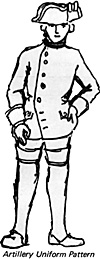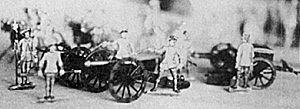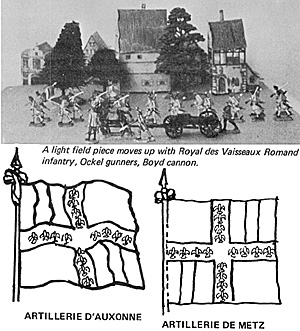
The basic French Artillery uniform of the 18th Century is as shown in the infantry regimental lists (Volume III No. 1) for the Regiment d'Artillerie. The latter regiment may have originated as a fusilier unit (to support the guns and keep gunners from running) and then branched out. That, however, is mere speculation on my part.
The royal blue coats with red facings and trousers, gold buttons, seems to be consistent for the period. Curiously, a print of English field artillery in 1745 published in the Military Prints From the British Museum shows similar colors, but even the enlisted men carry a lot of gold braid.
Around 1745-1763, French guns are shown red, like those of the British. Aloys Ochel (Keiler Zinnfguren) represents the French guns with black iron fittings over red, with black iron barrels on the heavy artillery.
Medium and heavy guns of 1745-63 were usually extremely cumbersome, and in the early part of the period, drawn by horses in single line rather than in teams. Movement was difficult, and the shifting of guns from one point to another was relatively rare by Napoleonic standards. Since the guns were difficult to move, bombardment by cannon ball was more prominent than close up assault with cannister and grape.
Mareshal de Saxe, on the other hand, resorted to "gallopers," very light weapons which could accompany manuevering cavalry and fire 2-3 lbs. of shot a little further than extreme musket range. These were used with effect against British squares during his campaigns in the Low Countries. Although deadly, the fire of these little guns rarely broke squares of steady infantry.
By the time of the American Revolution, the late M. Raymond Boverat stated, in a 1966 catalogue that the Gribeaval System with its carriages painted sky blue had arrived.
The artillery flags have divided fields of purple - green - purple diagonally opposed, with yellow in the remaining quarters. The white center cross dividing the quarters has f our f leurs de lys in gold on each arm. These two flags are from American and French Flags of the American Revolution, and were born by French Artillery regiments serving in the war.
A black and white photograph of the parent regiment, Royal Artillerie, appear some years ago in Revue Historique Militarie had, if memory serves correctly, a similar layout to the Metz flag, but with fleurs de lys in the center stripe of the tricolored fields. However, I can't vouch for that or the colors. Fortunately, since the battery and company are roughly equal, if you've got more than two artillery regiments in your Army, you're using two many guns anyway.
ARTILLERY UNIFORM PATTERN
Although the basic uniform of the French artillery was of infantry cut, gunners in action are sometimes depicted in a simple tunic similar to the undress uniform of some French Dragoon regiments of the same period.
Aloys Ochel, of Keiler Zinnfguren, provides an artillery driver in blue peasant smock with a cloth or fur cap with hanging bag - Such a driver, of course, could walk into action with any of the heavier pieces.
Artillery and Bibliographical Notes
 A recent reader inquiry on sources raised this painful subject. Do I make up everything from the whole cloth? Well, unfortunately, in recent travels, some of the book references and authors names have become misplaced. However, the following works have been most useful:
A recent reader inquiry on sources raised this painful subject. Do I make up everything from the whole cloth? Well, unfortunately, in recent travels, some of the book references and authors names have become misplaced. However, the following works have been most useful:
- Army List and Infantry Uniform Data:
Knoetel's Handbach de Uniformekunde
Illustrations and clarification of some descriptions:
(based on) "Infanterie Francaise dans la Guerre cle Sept Ans," Bulletin du S.C.F.H. (now merged with "The Sabatche.") (Also cavalry for the same period to be covered later.)
Flag descriptions
This is a very spotty area. The flags of the first 5 regiments on the Army list were taken from a French history, the name of which I have misplaced, which gave the first 24 units uniform, colonels flag, and ordinance flag colors. Others were drawn from La Mervaillence Histoire de l'Armie Francaise, illustrated by Gustav Dore and French and American Flags of the American Revolution which included the participating infantry flags as well as those of the Artillerle Regiments of Metz- and Auxonne. The flag of the Gardes Francaises is taken from Drapeaux de France, a jewel of a book which has disappeared to wherever the U.S. Navy Library went when Main Navy building was levelled.
Some conflicts occur. For example, Dore has drawn a "Grenadier de France" with yellow vest and turnbacks, while Knoetel has blue turned red. I could be wrong, but as La Mervailleuse Histoire is a popular illustrated history done early in the days of color printing, I followed Knoetel.
On the other hand, when Knoetel clashes with detailed information on 18th century French troops published by the "S.C.F.H. Sabertache," I consider the latter closer to the source.
Knoetel is usually more complete in the coverage of armies at a 20mm level of detail. However, his list of the French heavy cavalry is a garbled nightmare for a thumb and dictionary German translator of my meager talents.
For those readers who want to know how many coat buttons, and in what series, or even what pattern of coat fastenings to use, I can only suggest that the subject is too deep for me in this series. Fastenings for the turnbacks seem to resemble diamonds and hearts from a card deck, fleurs de lys, or practically anything.

More French Army in the Mid-18th Century
- Part 1: Infantry and Flags (1)
Part 2: French Infantry Regiments of the 7 Years War Uniform Chart
Part 3: Artillery
Part 4: Cavalry (1)
Part 5: Cavalry (2)
Part 6: Infantry
Back to The Armchair General Vol. 3 No. 2 Table of Contents
Back to The Armchair General List of Issues
Back to MagWeb Master Magazine List
© Copyright 1970 by Pat Condray
This article appears in MagWeb (Magazine Web) on the Internet World Wide Web. Other military history articles and gaming articles are available at http://www.magweb.com
